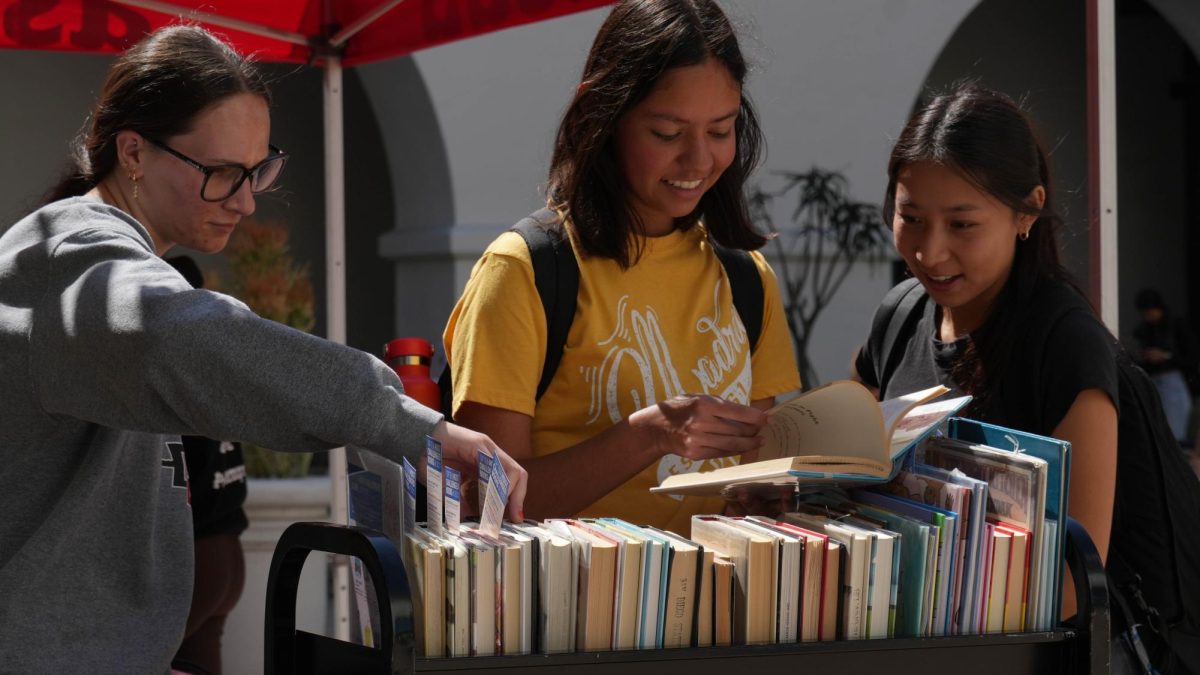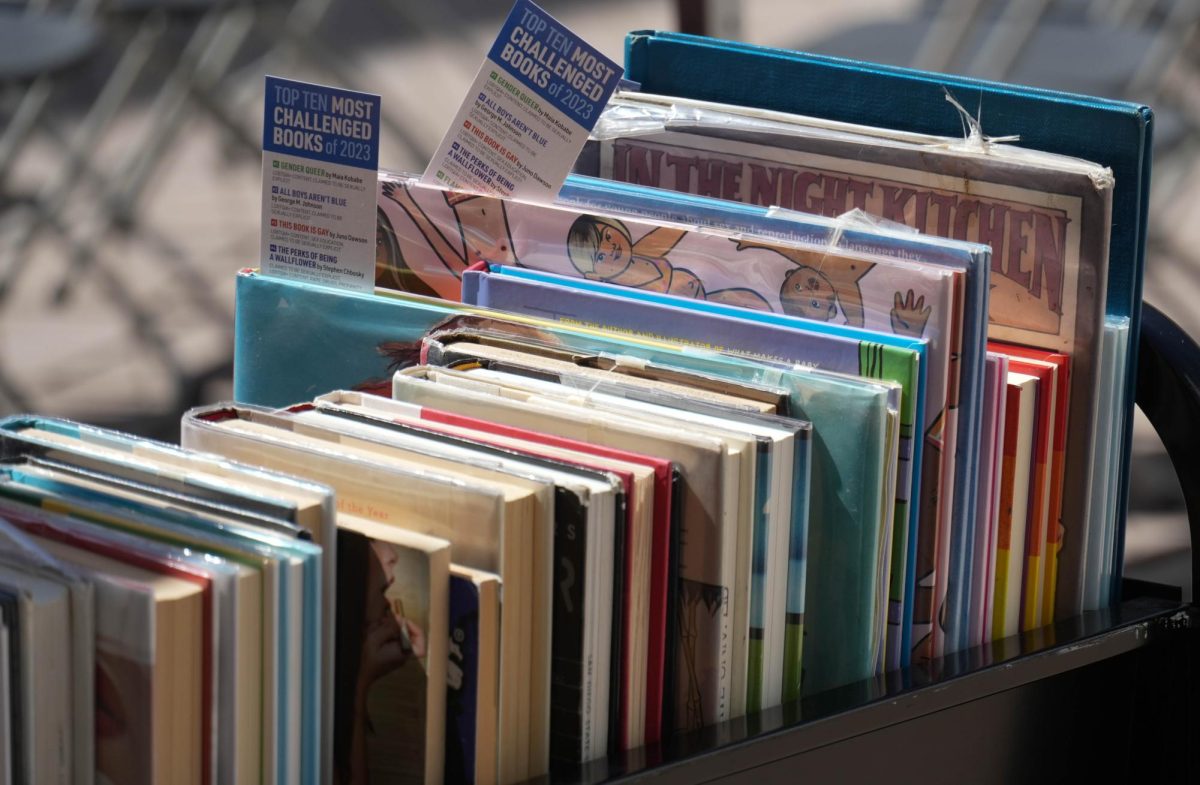On Sept. 26, SDSU students and faculty read excerpts from banned books during the Freed Between the Lines: Banned Books Week 2024 event, which was held in the Conrad Prebys Aztec Student Union Courtyard to celebrate the freedom to read and bring awareness to nation-wide book challenging and banning.
Freed Between the Lines was organized by library Dean Scott Walters in collaboration with Associated Students during Banned Books Week, which occurred this year from Sept. 22-28.
Passages from historically banned novels such as Harper Lee’s “To Kill a Mockingbird” and Khaled Hosseini’s “The Kite Runner” echoed through the courtyard, as well as lines from banned picture books like “In the Night Kitchen.”
This is the second time that Freed Between the Lines has happened at SDSU. However, Banned Books Week has occurred annually since its inception by the American Library Association (ALA) in 1982. The ALA reported there was a record number of challenged books in 2023, with a 65% increase in titles targeted for censorship and 4,240 unique book titles targeted for removal from schools and libraries.
While this year saw a decrease in the number of challenged titles compared to 2023, SDSU Associate Dean of Libraries for Collections and Discovery Services Randyn Heisserer-Miller, who kicked the event off, emphasized that the majority of those challenged titles “continue to be LGBTQIA+ and BIPOC in subject matter.”
Additionally, Heisserer-Miller discussed soft censoring in addition to explicit banning. He described it as a way for libraries to hide challenged books, where “libraries make preemptive decisions to put challenged titles in restricted areas, not use them in displays or otherwise.”
“These challenges are based in fear and not really understanding what libraries do or what that content actually is,” Heisserer-Miller said. “We see a lot of challenges for books and content that people don’t really understand what’s in there, or they don’t even know.”
Heisserer-Miller shared an excerpt from one of his favorite books, the graphic novel “Gender Queer” by Maia Kobabe. “Gender Queer” was 2023’s most challenged book of the year for its LGBTQIA+ content as well as claims of being sexually explicit.
As a member of the LGBTQIA+ community, Heisserer-Miller has a personal connection to the graphic novel and stressed the importance of Freed Between the Lines, specifically the issue of book banning targeting minority-representative literature.
“When I was coming of age, not being able to know who I was and figure that out on my own and being able to see those representations of myself at that age prolonged that struggle,” Heisserer-Miller said. “It’s important for public libraries to be able to have all of this information because when people are trying to figure themselves out or they are a marginalized community they should have the ability to go into a safe space and read about themselves.”
Prior to last year’s record-shattering amount of books being challenged, some SDSU students weren’t even aware books could be banned in the United States. One of those students was Trinity Dang, Associated Students vice president of university affairs and one of the organizers of Freed Between the Lines.
According to Dang, she was shocked when she noticed books from the Junie B. Jones series had been banned while researching for last year’s event.
“It really struck me off guard to learn that first of all, banned books were a thing,” Dang said. “To see that one of my favorite books from my childhood was being banned definitely shocked me.”
She said that experience motivated her to do more research into why and how some books become banned in the United States. .
“This affects a lot more students than people realize,” Dang said. “This experience and partnering with the library has enlightened me to this huge movement that’s going across nationwide, and hopefully it helped to promote how important it is to stay aware of what’s happening in universities and in schools and on campuses.”
Postsecondary educational leadership and student affairs (PELSA) graduate student Niki Majsterski didn’t have a certain book in mind when she decided to read during Freed Between the Lines and was nervous to read during the event. According to Majsterski, she was inspired by Vice President for Student Affairs and Campus Diversity Christopher Manning, who read Nick Bruel’s picture book “Bad Kitty”.
“[Dr. Manning] read ‘Bad Kitty’, and I didn’t know if that was banned ever,” Majsterski said. “I didn’t even know that banning books was a thing. And I think that this event really can inspire people to be brave and courageous. It can inspire them to just be heard.”
Majsterski is a member of Project Rebound, a program that allows formerly incarcerated people to obtain a degree from SDSU.
She said that being able to read during her incarceration was what saved her life, and she was inspired to read an excerpt from “Extremely Loud & Incredibly Close” by Jonathan Safran Foer, calling the opportunity to read a book that not everyone has legal access to an honor.
In light of Freed Between the Lines, Heisserer-Miller emphasized that the SDSU library is dedicated to upholding the freedom of information to the campus community, through events like Freed Between the Lines and everyday life.
“There’s a space for universities to make sure everyone is aware of the importance of intellectual freedom,” Heisserer-Miller said. “There’s this famous quote, that ‘a truly great library contains something that offends everybody,’ and I think libraries should because we need to make sure that we’re representing everything.”







